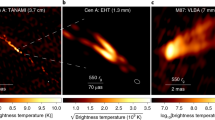Abstract
ONE of the most important features of the jovian decametric radioemission comes from the geometry of the observed radiation. The emission occurrence probability appears as a well defined function of the respective positions of Jupiter, the observer and the innermost galilean satellite Io, exhibiting several major sources which correspond to narrow ranges in zenocentric observer's longitude L (the so-called central meridian longitude) and in the synodic orbital phase of Io, Φ. These statistically established directivity properties were defined by Warwick1 and Alexander2, who showed that the repetition of the distinguishable dynamic spectra associated with each source occurring in a longitude range of 20°, is attributable to a ±10° beaming cone into which the radiation escapes in the ecliptic plane. Dulk3 stated more precisely that the emission is received on the Earth when Io makes certain angles with the line of sight, and that the dynamic spectrum varies in shape and frequency range with the magnetic longitude of Io. The beaming in latitude is also important4: the ±3.3° variation of the zenocentric declination of the Earth is sufficient to lead to a 15° variation of the statistical apparent sub-Io longitude of the emission. But these conclusions, based on statistics and on the repeatability of similar dynamic spectra in equivalent geometrical configurations of Jupiter, Io and the observer, are not decisive, as they were obtained from a single direction at a given time. We present here the first direct experimental proof of a narrow beaming of Jupiter radiation, using simultaneous observations in two different directions, during the French–Soviet space radio astronomy experiment Stereo-5.
This is a preview of subscription content, access via your institution
Access options
Subscribe to this journal
Receive 51 print issues and online access
$199.00 per year
only $3.90 per issue
Buy this article
- Purchase on Springer Link
- Instant access to full article PDF
Prices may be subject to local taxes which are calculated during checkout
Similar content being viewed by others
References
Warwick, J. W. Astrophys. J. 137, 41–60 (1963).
Alexander, J. K. Astrophys. J. 195, 227–233 (1975).
Dulk, G. A. thesis, Univ. (1965).
Lecacheux, A. Astr. Astrophys. 37, 301–304 (1974).
Poquérusse, M. & Steinberg, J. L. Astr. Astrophys. 65, L23–L26 (1978).
Boischot, A. Sol. Phys. 36, 517–522 (1974).
Lecacheux, A. & Rosolen, C. Astr. Astrophys. 41, 223–227 (1975).
Warwick, J. W., Dulk, G. A. & Riddle, A. C. Univ. Colorado Rep. PRA no. 3 (1975).
Smith, E. J., Davis, L. Jr & Jones, D. E. in Jupiter (ed. Gehrels, T.) 788–829 (University of Arizona Press, 1976).
Author information
Authors and Affiliations
Rights and permissions
About this article
Cite this article
POQUÉRUSSE, M., LECACHEUX, A. First direct measurement of the beaming of Jupiter's decametric radiation. Nature 275, 111–113 (1978). https://doi.org/10.1038/275111a0
Received:
Accepted:
Published:
Issue Date:
DOI: https://doi.org/10.1038/275111a0
This article is cited by
-
Beaming of Jupiter's decametric emission
Earth, Moon, and Planets (1986)
-
Beam structure of Jupiter's decametric radiation
Nature (1984)
-
Beaming of Jupiter's decametric radiation
Nature (1981)
Comments
By submitting a comment you agree to abide by our Terms and Community Guidelines. If you find something abusive or that does not comply with our terms or guidelines please flag it as inappropriate.



